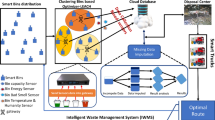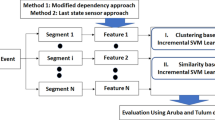Abstract
Semantic place prediction problem is the process of giving semantic names to locations. While the localization problem is about predicting the exact position, i.e. the coordinates, of a place, the aim here is to semantically characterize the location, such as home, school, restaurant. In order to solve the problem, phone usage patterns of crowds and the performed activities at different places can be utilized. In this study, we aim to semantically classify places visited by smart phone users utilizing the data collected from sensors and wireless interfaces available on the phones as well as phone usage patterns, such as battery level, and time-related information, with machine learning algorithms. For this purpose, we collected data from 15 participants at Galatasaray University for a duration of 1 month, in April 2016, and two of the users continued to collect 1 more month of data, which makes it 17 participants in total. We extract various set of features from the collected data and analyse the efficiency of features with different classification algorithms such as, decision tree, random forest, k-nearest neighbour, naive Bayes and multi-layer perceptron. We observe that, by fusing features extracted from different sources of data, better success rates are achieved. Moreover, we explore the relationship between places and activities, which was not explored in previous studies, and show that activities are important source of information for characterizing the places. Additionally, we observe that, while a generalized classifier performs reasonably well, using person-specific data and classification can help to improve the success rate.













Similar content being viewed by others
References
Coskun D (2014) Real-time activity recognition on smart phones. Master’s thesis, Galatasaray University
Coskun D, Incel O, Ozgovde A (2015) Phone position/placement detection using accelerometer: impact on activity recognition. In: Intelligent sensors, sensor networks and information processing (ISSNIP), 2015 IEEE tenth international conference, pp 1–6. doi:10.1109/ISSNIP.2015.7106915
Do TMT, Gatica-Perez D (2014) The places of our lives: visiting patterns and automatic labeling from longitudinal smartphone data. Mob Comput IEEE Trans 13(3):638–648
Eagle N, Pentland A (2006) Reality mining: sensing complex social systems. Pers Ubiquitous Comput 10(4):255–268
Hall M, Frank E, Holmes G, Pfahringer B, Reutemann P, Witten IH (2009) The WEKA data mining software: an update. ACM SIGKDD Explor Newslett 11(1):10–18
Junglas IA (2008) Location-based services. Commun ACM 51(3):65–69. doi:10.1145/1325555.1325568
Krumm J (2009) A survey of computational location privacy. Pers Ubiquitous Comput 13(6):391–399. doi:10.1007/s00779-008-0212-5
Krumm J, Rouhana D (2013) Placer: semantic place labels from diary data. In: Proceedings of the 2013 ACM international joint conference on pervasive and ubiquitous computing, ACM, pp 163–172
Krumm J, Rouhana D, Chang MW (2015) Placer++: semantic place labels beyond the visit. In: Pervasive computing and communications (PerCom), 2015 IEEE international conference, IEEE, pp 11–19
Laurila JK, Gatica-Perez D, Aad I, Bornet O, Do TMT, Dousse O, Eberle J, Miettinen M et al (2012) The mobile data challenge: big data for mobile computing research. In: Pervasive computing, paper no. EPFL-CONF-192489
Laurila JK, Gatica-Perez D, Aad I, Blom J, Bornet O, Do TMT, Dousse O, Eberle J, Miettinen M (2013) From big smartphone data to worldwide research: the mobile data challenge. Pervasive Mob Comput 9(6):752–771
Li G, Yu L, Ng WS, Wu W, Goh ST (2015) Predicting home and work locations using public transport smart card data by spectral analysis. In: Intelligent transportation systems (ITSC), 2015 IEEE 18th international conference, IEEE, pp 2788–2793
Lockhart JW, Pulickal T, Weiss GM (2012) Applications of mobile activity recognition. In: Proceedings of the 2012 ACM conference on ubiquitous computing, ACM, New York, UbiComp ’12, pp 1054–1058. doi:10.1145/2370216.2370441
Madan A, Cebrian M, Moturu S, Farrahi K, Pentland A (2012) Sensing the “health state” of a community. IEEE Pervasive Comput 11(4):36–45
Zhu Y, Zhong E, Lu Z, Yang Q (2013) Feature engineering for semantic place prediction. Pervasive Mob Comput 9(6):772–783
Acknowledgement
This work is supported by the Galatasaray University Research Fund under Grant Number 15.401.004 and by Tubitak under Grant Number 113E271.
Author information
Authors and Affiliations
Corresponding author
Rights and permissions
About this article
Cite this article
Celik, S.C., Incel, O.D. Semantic place prediction from crowd-sensed mobile phone data. J Ambient Intell Human Comput 9, 2109–2124 (2018). https://doi.org/10.1007/s12652-017-0549-6
Received:
Accepted:
Published:
Issue Date:
DOI: https://doi.org/10.1007/s12652-017-0549-6




